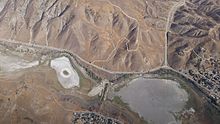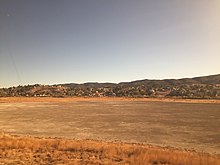| Elizabeth Lake | |
|---|---|
 In 2008 In 2008 | |
   | |
| Location | Sierra Pelona Mountains, Angeles National Forest, Los Angeles County, California |
| Coordinates | 34°39′57″N 118°24′09″W / 34.6658189°N 118.4025808°W / 34.6658189; -118.4025808 |
| Type | Sag pond |
| Basin countries | United States |
| Surface elevation | 3,228 ft (984 m) |
| Settlements | Elizabeth Lake, Lake Hughes |
Elizabeth Lake is a natural sag pond that lies directly on the San Andreas Fault in the northern Sierra Pelona Mountains, in northwestern Los Angeles County, southern California.
Geography


The lake, at 3,228 ft (984 m) in elevation, is within the Angeles National Forest. It is a natural perennial lake, but may dry up entirely during drought years. It is south of the western Antelope Valley.
Elizabeth Lake is one of a series of sag ponds created by the motion of the Earth's tectonic plates along the San Andreas Fault in the area, with others including Hughes Lake and the Munz Lakes. They are part of the northern upper Santa Clara River watershed.
The community of Elizabeth Lake is on the shore of the lake. It is administratively within the unincorporated community of Lake Hughes, and shares the same zip code.
History
Name
In 1780, the Spanish explorer-priest Junípero Serra named the lake La Laguna de Diablo (English: Devil's Lake), because some who lived nearby believed that within it dwelt a pet of the devil, which later came to be known as the Elizabeth Lake Monster. The creature is said to resemble a dragon, with leathery wings and scaly skin.
Sometime after 1834, the lake was called La Laguna de Liebre (English: Jackrabbit Lake) for a short time. Then in the 1840s it became known as La Laguna de Chico Lopez, for Francisco "Chico" Lopez, who grazed cattle on its banks.
Native American
Elizabeth Lake once marked a dividing point between the territories of the Tataviam, Kitanemuk, and Serrano tribes of Native Americans. The Tataviam may have called it Kivarum. The Vanyume, or desert Serrano, village of Tsivung was located near the lake.
Spain and Mexico
As early as the 1780s, the main inland route between southern and northern Spanish colonial Las Californias province was El Camino Viejo a Los Ángeles (English: the Old Road to Los Angeles). It became a well established inland route, and an alternative to the coastal El Camino Real trail used since the 1770s. Locally, it ascended the Sierra Pelona Mountains via San Francisquito Canyon, crossed through San Francisquito Pass, ran north to the lake, and then skirted it and continued northwest to Aguaje Lodoso (Mud Spring) in the Antelope Valley and westward to Cow Springs and the Cuddy Valley, and then down Cuddy Canyon to the San Joaquin Valley.
Another inland route diverged from the El Camino Viejo at Elizabeth Lake, going north to cross the western Antelope Valley and then up Cottonwood Creek canyon, to cross over the Tehachapi Mountains via Old Tejon Pass, and down Tejon Creek canyon to the San Joaquin Valley. After 1843, much of that section was within the Mexican Alta California land grant of Rancho Tejon. From 1849 to before 1854, it was the main road connecting the southern part of the state to the trail along the eastern side of the San Joaquin Valley to the goldfields to the north.
The Mexican land grant Rancho La Liebre was established in 1846 in Alta California, with its southeastern section in the Sierra Pelona Mountains near the lake.
United States
In the early 1850s, the vicinity of La Laguna de Chico Lopez was a frequent haunt of California grizzly bears—so numerous that cattle ranching was considered impossible.
In 1854, the route to the San Joaquin Valley shifted away from the Old Tejon Pass route to the Stockton - Los Angeles Road, using the Fort Tejon Pass, and the Grapevine Canyon. The later Butterfield Overland Mail shortened the route to Cow Springs avoiding Mud Springs, skirting Elizabeth Lake to its north westward via the San Andreas Rift to Oakgrove Canyon then north via Pine Canyon to Antelope Valley and westward again to Cow Springs.
The first building at the lake was La Casa de Miguel Ortiz, an adobe built by Miguel Ortiz, a muleteer, on land given him by his employer, wealthy landowner Edward Fitzgerald Beale. Southwest of the Ortiz Adobe was the Andrada Stage Station adobe, sited where the old Fort Tejon Road entered San Francisquito Canyon.
Circa 1915, there were hot springs in Elizabeth Lake Canyon. A U.S. government geologist reported, "They are not of high temperature nor notable flow, however, and are seldom visited. The San Andreas fault line is mapped as passing about 8 miles north of these springs, and its proximity suggests that the existence of the warm water may be due to subsidiary fracturing of the rocks."
The Crown Fire scorched 13,918 acres (5,632 ha) in the area and destroyed 10 residences in 2010. The lake was dry between 2013 and 2023 because of a drought.
Education
In 1869, the Los Angeles County Board of Supervisors designated the Elizabeth Lake School District to serve the area, which had the only established school between Los Angeles and Bakersfield. Land for the school was donated by Samuel and Almeda Frakes from their ranch lands. Children from the Lake Hughes, Elizabeth Lake, and Green Valley areas are still served by this school district. The 1869 wooden schoolhouse lasted until it was replaced by an adobe structure in the early 1930s, located on the east side of Elizabeth Lake Road, ¼ mile north of Andrada Corner at the intersection of San Francisquito and Elizabeth Lake Roads.
Lake Hughes
In 1924, Judge Hughes renamed the sag pond to the west of Elizabeth Lake to Lake Hughes, and created a recreational resort area around it.
See also
- Elizabeth Lake, California — community on lake
- List of lakes in California
- Category:Sierra Pelona Ridge – related topics
References
- Forest Service (May 2004). "Draft Land Management Plan: Part 2-Angeles National Forest Strategy" (.PDF). R5-MB-041. U.S. Department of Agriculture: 47. Retrieved March 22, 2009.
{{cite journal}}: Cite journal requires|journal=(help) - Lin II, Rong-Gong (March 21, 2017). "Notorious L.A. earthquake fault more dangerous than experts believed, new research shows". Los Angeles Times. Retrieved October 22, 2019.
- State Water Resources Control Board, Los Angeles (LARWQCB): Documents for the Santa Clara River Lakes (Elizabeth Lake, Munz Lake, Lake Hughes) Nutrient TMDL Archived 2016-09-14 at the Wayback Machine — homepage + links.
- "Mysterious L.A.: The Monster of Elizabeth Lake?". Los Angeles Almanac. 2009. Retrieved March 26, 2009.
- Mildred Brooke Hoover, E. G. Rensch and H. E. Rensch, Historic Spots In California: The Southern Counties, Stanford University Press, 1932, pp. 85–86
- Johnson, John R., Earle, David D., "Tataviam Geography and Ethnohistory", Journal of California and Great Basin Anthropology, Vol. 12, No. 2, pp. 191–214 (1990).
- Indians, San Fernando Band of Mission. "San Fernando Band of Mission Indians". San Fernando Band of Mission Indians. Retrieved April 21, 2023.
- Latta, Frank F. (1976). Saga of Rancho El Tejon. Exeter, California: Bear State Books. p. 65. ISBN 978-1-892622-30-3. Archived from the original on October 12, 2016. Retrieved August 27, 2016.
- Map of Passes in the Sierra Nevada from Walker's Pass to the Coast Range: from Explorations and Surveys made under the direction of the Hon. Jefferson Davis, Secretary of War, by Lieut. R.S. Williamson Topl. Engr. assisted by Lieut. J.G. Parke Topl. Engr. and Mr. Isaac Williams Smith, Civ. Engr. 1853. Explorations and Surveys for a Rail Road Route from the Mississippi River to the Pacific Ocean. War Department. Routes in California to connect with the routes near the 32nd and 35th parallels. Engraved by Selmar Siebert.
- Where Rolls the Kern: a History of Kern County, California; Herbert G. Comfort; Enterprise Press; Moorpark, Ca; 1934; (#255); Chapter IV, "The Founding of Fort Tejon; pp. 21-52. "Before 1854, the' main line of travel into the valley was straight North from Elizabeth Lake across Antelope Valley, entering the San Joaquin by way of the original Tejon Pass, at the head of Tejon Creek, above the present headquarters of Tejon Rancho. The establishment of the Fort Diverted this general travel to the West almost 29 miles to the present Tejon Pass, then known as Fort Tejon Pass. As the Tejon Creek Pass was abandoned, the name Tejon Pass came to be used solely for the pass leading into Canada de las Uvas."
- Horace Bell, Reminiscences of a ranger: or, early times in Southern California, Yarnell, Caystile & Mathes, printers, Los Angeles, 1881, p. 250
- Hoover, Rensch and Rensch, Historic Spots In California: The Southern Counties, pp. 85–86. — via Google Books.
- "Springs of California Gerald AshleyWaring Jan 1915 U.S. Government Printing Office Water-supply paper / Department of the Interior, United States Geological Survey no. 338-339 1914–15". HathiTrust. p. 66. Retrieved November 1, 2023.
- Simmons, Ann (July 31, 2010). "Crown fire grows to more than 13,000 acres". Los Angeles Times. Retrieved August 19, 2015.
- "Record rainfall season refill Elizabeth Lake". Reuters. Retrieved December 28, 2024.
- Gurba, Norma (2013). Legendary Locals of the Antelope Valley. ISBN 9781467100878.
- Ameluxen, Jack and Louise. Discover Green Valley Local History, Folktales and Facts (Second ed.). p. 36.
External links
- U.S. Geological Survey Geographic Names Information System: Elizabeth Lake (Los Angeles County, California)
- Weird California - The Monster of Elizabeth Lake
- Abobes of Rancho La Liebre